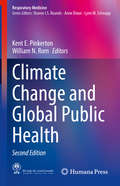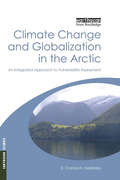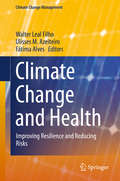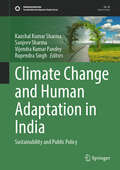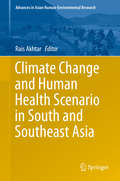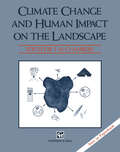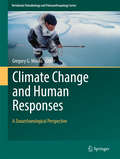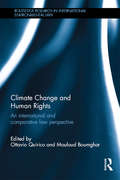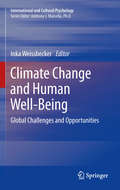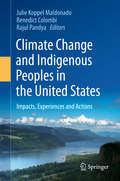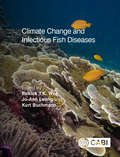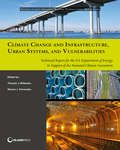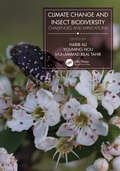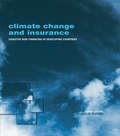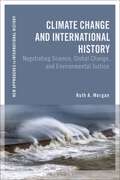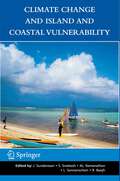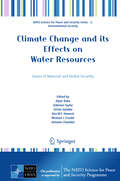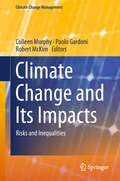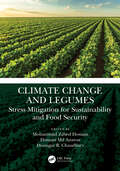- Table View
- List View
Climate Change and Global Public Health: Air Pollution, Global Climate Change, And Wilderness (Respiratory Medicine #7)
by Kent E. Pinkerton William N. RomThis book is a guide to the research, findings, and discussions of US and international experts on climate change and respiratory health. Since the publication of the first edition, climate change has been increasingly acknowledged as being directly related to the prevalence and incidence of respiratory morbidity. Evidence is increasing that climate change does drive respiratory disease onset and exacerbation as a result of increased ambient and indoor air pollution, desertification, heat stress, wildfires, and the geographic and temporal spread of pollens, molds and infectious agents. This second edition is fully updated to include the latest research by international experts on topics such as heat waves causing critical care-related diseases, climate-driven air pollution increases, and high-level ozone and ozone exposure linked to idiopathic pulmonary fibrosis, lung cancer, and acute lower respiratory infection. Seven new chapters have also been added on extreme weather and agricultural safety in California; desert dust effects on lung health; climate policy and the EPA; California's integrated approach to air quality and climate change; integrating climate change, the environment, and sustainability themes into professional health science courses; and the role of the physician as climate advocate. This is an ideal guide for all pulmonologists and health professionals treating patients with pulmonary disease.
Climate Change and Globalization in the Arctic: An Integrated Approach to Vulnerability Assessment
by E. Carina KeskitaloClimate change vulnerability assessment is a rapidly developing field. However, despite the fact that such major trends as globalization and the changing characteristics of the political and economic governance systems are crucial in shaping a community?s capacity to adapt to climate change, these trends are seldom included in assessments. This book addresses this shortcoming by developing a framework for qualitative vulnerability assessment in ?multiple impact? studies (of climate change and globalization) and applying this framework to several cases of renewable natural resource use. The book draws upon case studies of forestry and fishing - two of the largest sectors that rely on renewable natural resources - and reindeer herding in the European North. The study represents a bottom-up view, originating with the stakeholders themselves, of the degree to which stakeholders find adaptation to climate change possible and how they evaluate it in relation to their other concerns, notably economic and political ones. Moreover, the approach and research results include features that could be broadly generalized to other geographic areas or sectors characterized by renewable natural resource use.
Climate Change and Globalization in the Arctic: An Integrated Approach to Vulnerability Assessment
by E. Carina KeskitaloClimate change vulnerability assessment is a rapidly developing field. However, despite the fact that such major trends as globalization and the changing characteristics of the political and economic governance systems are crucial in shaping a community?s capacity to adapt to climate change, these trends are seldom included in assessments. This book addresses this shortcoming by developing a framework for qualitative vulnerability assessment in ?multiple impact? studies (of climate change and globalization) and applying this framework to several cases of renewable natural resource use. The book draws upon case studies of forestry and fishing - two of the largest sectors that rely on renewable natural resources - and reindeer herding in the European North. The study represents a bottom-up view, originating with the stakeholders themselves, of the degree to which stakeholders find adaptation to climate change possible and how they evaluate it in relation to their other concerns, notably economic and political ones. Moreover, the approach and research results include features that could be broadly generalized to other geographic areas or sectors characterized by renewable natural resource use.
Climate Change and Health: Improving Resilience and Reducing Risks (Climate Change Management)
by Walter Leal Filho Ulisses M. Azeiteiro Fátima AlvesA major objective of this volume is to create and share knowledge about the socio-economic, political and cultural dimensions of climate change. The authors analyze the effects of climate change on the social and environmental determinants of the health and well-being of communities (i.e. poverty, clean air, safe drinking water, food supplies) and on extreme events such as floods and hurricanes. The book covers topics such as the social and political dimensions of the ebola response, inequalities in urban migrant communities, as well as water-related health effects of climate change. The contributors recommend political and social-cultural strategies for mitigate, adapt and prevent the impacts of climate change to human and environmental health. The book will be of interest to scholars and practitioners interested in new methods and tools to reduce risks and to increase health resilience to climate change.
Climate Change and Human Adaptation in India: Sustainability and Public Policy (Sustainable Development Goals Series)
by Sanjeev Sharma Kaushal Kumar Sharma Vijendra Kumar Pandey Rupendra SinghThis contributed volume presents an attempt to understand climatic variability and induced risk to livelihood of communities and to offer insights on how catastrophic conditions and crises can be mitigated through public policy interventions. The case studies herein offer insights into different spheres and domains affected by climate change and present models of adaptation possibilities. The book is divided into three thematic sections. The first contains chapters that deal with assessing the effects of climate change. The second section offers perspectives on adaptation and governance, vulnerability in the context of sustainable livelihoods. The third and last section looks at Policy and Governance, with respect to climatic change adaptation and mitigations. The lessons contained in this volume are useful to a wide audience including research scholars, students, policymakers, and planners.
Climate Change and Human Health Scenario in South and Southeast Asia (Advances in Asian Human-Environmental Research)
by Rais AkhtarThis book is the first to present a regional analysis of climate change and human health, focusing on geographically and socio-economically distinct countries of South and Southeast Asia. It has a major focus on India, Indonesia, Bangladesh, Malaysia, Thailand, Nepal and Taiwan. Climate change is a significant and emerging threat to human health. lt represents a range of environmental hazards and will affect populations in both the developed and developing countries. In particular, it affects the regions where the current burden of climate-sensitive diseases are high, which is the case in South and Southeast Asian countries.
Climate Change and Human Impact on the Landscape: Studies in palaeoecology and environmental archaeology
by F. M. ChambersI am pleased to present this volume of invited reviews and research case studies, produced to mark the retirement of Professor A. G. Smith - one of the leading researchers in Holocene palaeoecology. A. G. Smith took his first degree at the University of Sheffield, graduating in 1951 with a first-class honours degree in Botany. His doctorate was awarded in 1956 for a study in late-Quaternary vege tational history, based in the Sub-Department of Quaternary Research at the University of Cambridge, under the supervision of the late Sir Harry Godwin, FRS. He then researched and taught at Queen's University, Belfast, from 1954, leading the Nuffield Quaternary Research Unit there, becoming Co-Director of the Palaeoecology Laboratory from 1964. He was appointed Professor and Head of the Department of Botany (later, Plant Science) at University College, Cardiff, in 1973, and retired from the School of Pure and Applied Biology at the renamed University of Wales College, Cardiff, in August 1991. Although his principal interests have been concerned with the post-glacial environmental history of the British Isles, Professor Smith has significantly in fluenced many researchers elsewhere in their interpretation of biological and other evidence for human modification of the natural environment.
Climate Change and Human Responses: A Zooarchaeological Perspective (Vertebrate Paleobiology and Paleoanthropology)
by Gregory MonksThis book contributes to the current discussion on climate change by presenting selected studies on the ways in which past human groups responded to climatic and environmental change. In particular, the chapters show how these responses are seen in the animal remains that people left behind in their occupation sites. Many of these bones represent food remains, so the environments in which these animals lived can be identified and human use of those environments can be understood. In the case of climatic change resulting in environmental change, these animal remains can indicate that a change has occurred, in climate, environment and human adaptation, and can also indicate the specific details of those changes.
Climate Change and Human Rights: An International and Comparative Law Perspective (Routledge Research in International Environmental Law)
by Ottavio Quirico Mouloud BoumgharDo anthropogenic greenhouse gas emissions affect human rights? Should fundamental rights constrain climate policies? Scientific evidence demonstrates that anthropogenic greenhouse gas emissions contribute to increasing atmospheric temperatures, soon passing the compromising threshold of 2° C. Consequences such as Typhoon Haiyan prove that climate alteration has the potential to significantly impair basic human needs. Although the United Nations Framework Convention on Climate Change and human rights regulatory regimes have so far proceeded separately, awareness is arising about their reciprocal implications. Based on tripartite fundamental obligations, this volume explores the relationship between climate change and interdependent human rights, through the lens of an international and comparative perspective. Along the lines of the metaphor of the ‘wall’, the research ultimately investigates the possibility of overcoming the divide between universal rights and climate change, and underlying barriers. This book aims to be a useful resource not only for practitioners, policymakers, academics, and students in international, comparative, environmental law and politics and human rights, but also for the wider public.
Climate Change and Human Rights: An International and Comparative Law Perspective (Routledge Research in International Environmental Law)
by Ottavio Quirico Mouloud BoumgharDo anthropogenic greenhouse gas emissions affect human rights? Should fundamental rights constrain climate policies? Scientific evidence demonstrates that anthropogenic greenhouse gas emissions contribute to increasing atmospheric temperatures, soon passing the compromising threshold of 2° C. Consequences such as Typhoon Haiyan prove that climate alteration has the potential to significantly impair basic human needs. Although the United Nations Framework Convention on Climate Change and human rights regulatory regimes have so far proceeded separately, awareness is arising about their reciprocal implications. Based on tripartite fundamental obligations, this volume explores the relationship between climate change and interdependent human rights, through the lens of an international and comparative perspective. Along the lines of the metaphor of the ‘wall’, the research ultimately investigates the possibility of overcoming the divide between universal rights and climate change, and underlying barriers. This book aims to be a useful resource not only for practitioners, policymakers, academics, and students in international, comparative, environmental law and politics and human rights, but also for the wider public.
Climate Change and Human Well-Being: Global Challenges and Opportunities (International and Cultural Psychology)
by Inka WeissbeckerClimate change is increasing the severity of disasters and adverse weather conditions worldwide, with particularly devastating effects on developing countries and on individuals with lower resources. Climate change is likely to impact mental health and psychosocial well-being via multiple pathways, leading to new challenges. Direct effects such as gradual environmental changes, higher temperatures, and natural disasters, are likely to lead to more indirect consequences such as social and economic stressors, population displacement, and conflict. Climate change, largely the product of industrialized nations, is projected to magnify existing inequalities and to impact the most vulnerable, including those with low resources, individuals living in developing countries and specific populations such as women, children and those with pre-existing disabilities. This book outlines areas of impact on human well being, consider specific populations, and shed light on mitigating the impact of climate change. Recommendations discuss ways of strengthening community resilience, building on local capacities, responding to humanitarian crises, as well as conducting research and evaluation projects in diverse settings.
Climate Change and Indigenous Peoples in the United States: Impacts, Experiences and Actions
by Julie Koppel Maldonado Colombi Benedict Rajul Pandya Benedict J. ColombiWith a long history and deep connection to the Earth’s resources, indigenous peoples have an intimate understanding and ability to observe the impacts linked to climate change. Traditional ecological knowledge and tribal experience play a key role in developing future scientific solutions for adaptation to the impacts. The book explores climate-related issues for indigenous communities in the United States, including loss of traditional knowledge, forests and ecosystems, food security and traditional foods, as well as water, Arctic sea ice loss, permafrost thaw and relocation. The book also highlights how tribal communities and programs are responding to the changing environments. Fifty authors from tribal communities, academia, government agencies and NGOs contributed to the book.Previously published in Climatic Change, Volume 120, Issue 3, 2013.
Climate Change and Infectious Fish Diseases
by Patrick T.K. Woo Jo-Ann Leong Kurt BuchmannClimate change with global warming is not disputed by the vast majority of scientists and the aquatic system is most affected. A global rise in water temperature and acidification of the aquatic environment will continue even if we can significantly reduce the current output of the two most important greenhouse gasses (carbon dioxide and methane). These and other environmental changes will affect fish health which includes infectious pathogens. This important new text is the second volume on climate change and fish health. It covers changes to the freshwater ecosystem and their current and expected effects on selected infectious diseases of fish. The book represents contributions by over 50 experts from 18 countries. Comprehensive and thought-provoking, the book details abiotic and biotic environmental changes in temperate and tropical freshwater ecosystems, sequestrations of atmospheric carbon dioxide and effects on infectious diseases (12 microbial and 10 parasitic) in economically important fish in tropical, subtropical and temperate waters. The text is key reading for fish disease scientists, aquatic ecologists, fish health consultants, veterinarians, policy makers and all who are interested in fish health and the environment.
Climate Change and Infrastructure, Urban Systems, and Vulnerabilities: Technical Report for the U.S. Department of Energy in Support of the National Climate Assessment (NCA Regional Input Reports)
by Thomas J. Wilbanks and Steven FernandezHurricane Irene ruptured a Baltimore sewer main, resulting in 100 million gallons of raw sewage flooding the local watershed. Levee failures during Hurricane Katrina resulted in massive flooding which did not recede for months. With temperatures becoming more extreme, and storms increasing in magnitude, American infrastructure and risk-management policies require close examination in order to decrease the damage wrought by natural disasters. Climate Change and Infrastructure, Urban Systems, and Vulnerabilities addresses these needs by examining how climate change affects urban buildings and communities, and determining which regions are the most vulnerable to environmental disaster. It looks at key elements of urban systems, including transportation, communication, drainage, and energy, in order to better understand the damages caused by climate change and extreme weather. How can urban systems become more resilient? How can citizens protect their cities from damage, and more easily rebound from destructive storms? This report not only breaks new ground as a component of climate change vulnerability and impact assessments but also highlights critical research gaps in the material. Implications of climate change are examined by assessing historical experience as well as simulating future conditions.Developed to inform the 3rd National Climate Assessment, and a landmark study in terms of its breadth and depth of coverage and conducted under the auspices of the U.S. Department of Energy, Climate Change and Infrastructure, Urban Systems, and Vulnerabilities examines the known effects and relationships of climate change variables on American infrastructure and risk-management policies. Its rich science and case studies will enable policymakers, urban planners, and stakeholders to develop a long-term, self-sustained assessment capacity and more effective risk-management strategies.
Climate Change and Insect Biodiversity: Challenges and Implications
by Habib Ali Youming Hou Muhammad Bilal TahirThis up-to-date reference book discusses the effects of climate change on the biodiversity of insect pests. The changing climate and agricultural intensification practices impact negatively on insect biodiversity. The book explains the significance of insect pests for evaluating climatic impacts on a wide range of ecological systems. It covers the effect of climate change on pollinators and household and agricultural insect pests. It explains how climate-smart agriculture can enhance productivity and food security.FEATURES Reviews the effects of climate change on plant-insect interactions Includes topics such as insect biodiversity informatics and conservation Discusses food security, pest management, and beneficial and social insects Covers topics such as precision agriculture and climate-smart agriculture Provides insights on the relation between agriculture intensification and insect biodiversity This book is meant for scientists, researchers, and students working in the fields of agriculture, entomology, ecology, plant science, environmental biology, and biotechnology.
Climate Change and Insect Biodiversity: Challenges and Implications
This up-to-date reference book discusses the effects of climate change on the biodiversity of insect pests. The changing climate and agricultural intensification practices impact negatively on insect biodiversity. The book explains the significance of insect pests for evaluating climatic impacts on a wide range of ecological systems. It covers the effect of climate change on pollinators and household and agricultural insect pests. It explains how climate-smart agriculture can enhance productivity and food security.FEATURES Reviews the effects of climate change on plant-insect interactions Includes topics such as insect biodiversity informatics and conservation Discusses food security, pest management, and beneficial and social insects Covers topics such as precision agriculture and climate-smart agriculture Provides insights on the relation between agriculture intensification and insect biodiversity This book is meant for scientists, researchers, and students working in the fields of agriculture, entomology, ecology, plant science, environmental biology, and biotechnology.
Climate Change and Insurance: Disaster Risk Financing in Developing Countries
by Eugene N. GurenkoClimate change brings about a new set of major economic risks arising from changing weather patterns, extreme weather events and rising sea levels. Most at risk are developing countries who, despite considerable post-disaster donor aid, have been bearing the major brunt of disaster-related losses. One adaptation solution that is rapidly gaining the support of countries and international donors is a risk transfer to the global reinsurance and capital markets. This volume, a special issue of the journal Climate Policy, explores the role that insurance-based mechanisms can play in helping developing countries prepare for climate change. It offers a unique and comprehensive perspective on the potential role of insurance solutions in global adaptation to climate change and attempts to engender debate on the role of insurance in reducing global emissions and encouraging climate-friendly corporate behaviour.
Climate Change and Insurance: Disaster Risk Financing in Developing Countries
by Eugene N. GurenkoClimate change brings about a new set of major economic risks arising from changing weather patterns, extreme weather events and rising sea levels. Most at risk are developing countries who, despite considerable post-disaster donor aid, have been bearing the major brunt of disaster-related losses. One adaptation solution that is rapidly gaining the support of countries and international donors is a risk transfer to the global reinsurance and capital markets. This volume, a special issue of the journal Climate Policy, explores the role that insurance-based mechanisms can play in helping developing countries prepare for climate change. It offers a unique and comprehensive perspective on the potential role of insurance solutions in global adaptation to climate change and attempts to engender debate on the role of insurance in reducing global emissions and encouraging climate-friendly corporate behaviour.
Climate Change and International History: Negotiating Science, Global Change, and Environmental Justice (New Approaches to International History)
by Ruth A. MorganExploring how climate change has configured the international arena since the 1950s, this book reveals the ways in which climate change emerged and evolved as an international problem, and how states, scientists and NGOs have engaged in diplomatic efforts to address it. Developing amidst the Cold War, decolonization and a growing transnational environmental consciousness, it asks how this wider historical context has shaped our response to the greatest threat to humankind to date. Thinking beyond the science of climate change to the way it is received and responded to, Ruth Morgan shows how climate science has been mobilised in the political sphere, paying particular attention to the expansion of climate diplomacy into the Global South. The privileging of climate science and the emergence of climate scepticism are explored to consider how they have undermined efforts to remedy this planetary problem. Studying climate change and international history in tandem, this book explains the origins of the debates around this environmental emergency, the response of political leaders attempting to address the threat, and the barriers we face in creating an international regime to resolve the climate crisis.
Climate Change and International History: Negotiating Science, Global Change, and Environmental Justice (New Approaches to International History)
by Ruth A. MorganExploring how climate change has configured the international arena since the 1950s, this book reveals the ways in which climate change emerged and evolved as an international problem, and how states, scientists and NGOs have engaged in diplomatic efforts to address it. Developing amidst the Cold War, decolonization and a growing transnational environmental consciousness, it asks how this wider historical context has shaped our response to the greatest threat to humankind to date. Thinking beyond the science of climate change to the way it is received and responded to, Ruth Morgan shows how climate science has been mobilised in the political sphere, paying particular attention to the expansion of climate diplomacy into the Global South. The privileging of climate science and the emergence of climate scepticism are explored to consider how they have undermined efforts to remedy this planetary problem. Studying climate change and international history in tandem, this book explains the origins of the debates around this environmental emergency, the response of political leaders attempting to address the threat, and the barriers we face in creating an international regime to resolve the climate crisis.
Climate Change and Island and Coastal Vulnerability
by J. Sundaresan S. Sreekesh A. L. Ramanathan Leonard Sonnenschein Ram Boojh"Climate Change and Island and Coastal Vulnerability” is the outcome of a selection of peer reviewed edited papers presented at the International Workshop on Climate Change and Island Vulnerability (IWCCI) held at Kadmat Island, Lakshadweep, India in October 2010. Marine and coastal biodiversity, sea level rise vulnerability, fisheries, climate change impact on livelihood options, water and sanitation in island ecosystem and mitigation, adaptation and governance are the focal themes. The basic concept conveyed in the book is that biodiversity of islands is to be protected as a natural mechanism to mitigate climate change. Probability recurrence of mass coral bleaching and the management of coral reefs and their future protection are discussed in this book. Marine productivity and climate change for the last ten thousand years in the Arabian Sea have been examined with core records. Green technology is suggested as an important tool for mitigation and adaptation programmes in climate change. Measures taken to project biomass utilisation of islands as an energy source is delineated. Climate change may pose a potential threat on human health. Improved sanitation packages and models that are cost effective and environment-friendly for islands are uniquely presented in this book.
Climate Change and its Effects on Water Resources: Issues of National and Global Security (NATO Science for Peace and Security Series C: Environmental Security)
by Alper Baba, Gökmen Tayfur, Orhan J. Gündüz, Ken W.F. Howard, Michael J. W. F. Friedel and Antonio ChambelNational and global security can be assessed in many ways but one underlying factor for all humanity is access to reliable sources of water for drinking, sanitation, food production and manufacturing industry. In many parts of the world, population growth and an escalating demand for water already threaten the sustainable management of available water supplies. Global warming, climate change and rising sea level are expected to intensify the resource sustainability issue in many water-stressed regions of the world by reducing the annual supply of renewable fresh water and promoting the intrusion of saline water into aquifers along sea coasts, where 50% of the global population reside. Pro-active resource management decisions are required, but such efforts would be futile unless reliable predictions can be made about the impact of the changing global conditions on the water cycle and the quality and availability of critical water reserves. Addressing this wide spectrum of issues, a team of expert authors discusses here the impacts of climate change on the global water resources, the long-term resource management goals at global and local scales, the data requirements and the scientific and technical advances necessary to mitigate the associated impacts.
Climate Change and Its Impacts: Risks and Inequalities (Climate Change Management)
by Colleen Murphy Paolo Gardoni Robert McKimResponding to a need for a deeper and more nuanced understanding of the consequences of climate change, this book brings experts in climate science, engineering, urban planning, and conservation biology into conversation with scholars in law, geography, anthropology and ethics. It provides insights into how climate change is conceptualized in different fields. The book also aims to contribute to developing successful and multifaceted strategies that promote global, intergenerational and environmental justice. Among the topics addressed are the effects of climate change on the likelihood and magnitude of natural hazards, an assessment of civil infrastructure vulnerabilities, resilience assessment for coastal communities, an ethical framework to evaluate behavior that contributes to climate change, as well as policies and cultural shifts that might help humanity to respond adequately to climate change.
Climate Change and Legumes: Stress Mitigation for Sustainability and Food Security
by Mohammad Zabed Hossain Hossain Anawar Doongar R. ChaudharyGlobal climate change has created unprecedented challenges for human civilization due to its widespread adverse consequences, including a reduction in crop yield and threatening food security across the globe. Among the crop plants, legumes have great potential for ameliorating global warming since they can reduce carbon emissions by lowering reliance on the application of chemical fertilizers, by increasing nitrification and carbon sequestration in soil, and by providing protein-rich diets to both humans and livestock. This book identifies the extent of climate-induced stresses on legume plants and focuses on achieving food security through sustainable agricultural practices.This book compiles recent research findings and reviews on climate-related problems, the potential of legumes in ameliorating the impacts of climate change, as well as better management of agricultural land and practices for achieving environmental sustainability and food security.This book will serve as guidelines for scientists, agricultural practitioners, and policymakers working to achieve food security and better management of climate-induced stresses in agricultural interventions. It will also be useful as a reference book for researchers and students of both graduate and postgraduate levels. Furthermore, this book will provide enhanced knowledge about the mechanisms of yield and stress tolerance of legumes as well as developing climate-smart crops and improving cropping systems for a sustainable environment and food security. Features of the book Reviews trends of global climate change and its consequences for food security across the continents Identifies the challenges and scopes of cultivating legumes in achieving food security in the context of global climate change Focuses on the improvements of legume production through conservation approaches in agricultural practices and modern techniques, including omics-based breeding, biotechnology, genetic engineering, and rhizobium technology Discusses the sustainable amelioration options for soils affected by climate-induced stresses Cites examples of applications of rhizobium technologies in reducing greenhouse gas emission Describes pathways associated with yield, resistance, and tolerance of legumes to climate-induced stresses
Climate Change and Legumes: Stress Mitigation for Sustainability and Food Security
Global climate change has created unprecedented challenges for human civilization due to its widespread adverse consequences, including a reduction in crop yield and threatening food security across the globe. Among the crop plants, legumes have great potential for ameliorating global warming since they can reduce carbon emissions by lowering reliance on the application of chemical fertilizers, by increasing nitrification and carbon sequestration in soil, and by providing protein-rich diets to both humans and livestock. This book identifies the extent of climate-induced stresses on legume plants and focuses on achieving food security through sustainable agricultural practices.This book compiles recent research findings and reviews on climate-related problems, the potential of legumes in ameliorating the impacts of climate change, as well as better management of agricultural land and practices for achieving environmental sustainability and food security.This book will serve as guidelines for scientists, agricultural practitioners, and policymakers working to achieve food security and better management of climate-induced stresses in agricultural interventions. It will also be useful as a reference book for researchers and students of both graduate and postgraduate levels. Furthermore, this book will provide enhanced knowledge about the mechanisms of yield and stress tolerance of legumes as well as developing climate-smart crops and improving cropping systems for a sustainable environment and food security. Features of the book Reviews trends of global climate change and its consequences for food security across the continents Identifies the challenges and scopes of cultivating legumes in achieving food security in the context of global climate change Focuses on the improvements of legume production through conservation approaches in agricultural practices and modern techniques, including omics-based breeding, biotechnology, genetic engineering, and rhizobium technology Discusses the sustainable amelioration options for soils affected by climate-induced stresses Cites examples of applications of rhizobium technologies in reducing greenhouse gas emission Describes pathways associated with yield, resistance, and tolerance of legumes to climate-induced stresses
